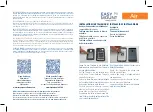
15
1.23. RADIAL CONVEYORS
Ensure the conveyor is operating correctly in its radial action and that the radial track
line is clear and free from debris etc. It is important that all linch pins are inspected to
ensure they are correctly positioned and the safety retaining pins are secure. Remove
wheel covers and inspect wheel mounting shafts and bearings for any damage and
wear. Drive shaft bearings should be greased. The manufacturer’s recommended
lubricant is a high quality lithium based grease of 2-3 consistency. Ensure motor
mounting bracket is secure and replace covers and secure fixings. Inspect hydraulics
as per Section 1.24. Radial slewing anchor bearings should be greased when required.
Tightness of Lindaptor fixings should be regularly checked and tightened to a torque
of 147Nm. (recommended every 6 months). Ensure ground fixing anchors are still
secure and tight. Visually inspect electrical wiring and connections for any signs of
damage. Any electrical maintenance work required should be carried out by a qualified
electrician.
1.24. MOBILE & RADIAL HYDRAULICS
Visually check that there are no leakages or damage at hose connections, along the
hose length and the ram. Check safety linch pins are correctly inserted and retained.
Try and elevate the conveyor to its maximum position. If the conveyor will not reach
this position, it is an indication that there is insufficient hydraulic oil in the system. Next
lower the conveyor to its lowest position, ensuring that the hydraulic ram is in its closed
position. Proceed to add oil to the hydraulic pump as necessary.
1.25. CONVEYOR WASHDOWN
Periodic washing and cleaning of your conveyor will be necessary to maintain its
efficient operation. The manufacturers recommend the use of a high power water jet
or similar (e.g. steam cleaner). Correct PPE should be worn when carrying out
washing etc. Prior to undertaking any washing, the environment the conveyor is
situated in should be considered and that no damage of surrounding items is likely to
occur. Ensure there is adequate drainage prior to washing. Excessive material should
be disposed of in a manner that will not cause damage to the environment. It will be
necessary to remove conveyor covers to give access to the belt area (see Sections
1.12 & 1.13). Ideally the belt tension should be released allowing the belt to be raised
to gain access to the inside of the conveyor frame. Particular attention and thorough
washing will be required around the head and tail drum areas.
1.26. DOCUMENTATION
All maintenance should be documented accordingly in the section at the rear of this
Service & Maintenance Schedule.
WARNING!
ENSURE ALL COVERS & GUARDS HAVE BEEN
REPLACED PRIOR TO RE-STARTING YOUR CONVEYOR
AND THAT ALL FIXINGS ARE TIGHT & SECURE.








































